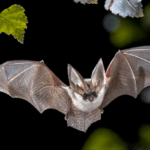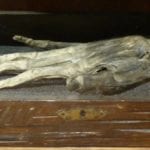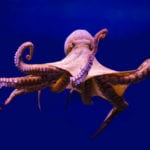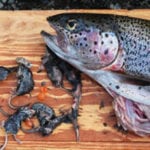 Mysteries
Mysteries  Mysteries
Mysteries  History
History 10 Surprising Stories About the Texas Rangers
 Humans
Humans 10 Philosophers Who Were Driven Mad by Their Own Theories
 Miscellaneous
Miscellaneous 10 Video-Game-Worthy Weapons and Armors from History
 Weird Stuff
Weird Stuff 10 Psychics Who Accurately Predicted Wartime Events
 The Arts
The Arts 10 Pieces of Art Inspired by a Broken Heart
 Health
Health 10 Science Fiction-Sounding New Medical Treatments
 History
History 10 Surprising Facts About the Father of Submarine Warfare
 Space
Space Ten Astonishing New Insights into Alien Worlds
 Weird Stuff
Weird Stuff 10 Bizarre Summer Solstice Rituals Still Practiced Today
 Mysteries
Mysteries Top 10 Haunting Facts About the Ghost Ship MV Alta
 History
History 10 Surprising Stories About the Texas Rangers
 Humans
Humans 10 Philosophers Who Were Driven Mad by Their Own Theories
Who's Behind Listverse?

Jamie Frater
Head Editor
Jamie founded Listverse due to an insatiable desire to share fascinating, obscure, and bizarre facts. He has been a guest speaker on numerous national radio and television stations and is a five time published author.
More About Us Miscellaneous
Miscellaneous 10 Video-Game-Worthy Weapons and Armors from History
 Weird Stuff
Weird Stuff 10 Psychics Who Accurately Predicted Wartime Events
 The Arts
The Arts 10 Pieces of Art Inspired by a Broken Heart
 Health
Health 10 Science Fiction-Sounding New Medical Treatments
 History
History 10 Surprising Facts About the Father of Submarine Warfare
 Space
Space Ten Astonishing New Insights into Alien Worlds
 Weird Stuff
Weird Stuff 10 Bizarre Summer Solstice Rituals Still Practiced Today
Top 10 Animals With Amazing Regeneration Powers
Humans are generally pretty weak animals. If you cut off your finger you are not getting it back unless you are lucky enough to have a team of highly trained surgeons and a hospital nearby. Even then you may not recover full use of it. But what if you could regrow lost body parts?
Of course to some extent we do heal from wounds but our puny human bodies are nothing compared to some animals. Here are ten animals with the power to regenerate their bodies that put humans to shame.
10 Ageless Animals That Do Not Grow Old
10 Sea Slug
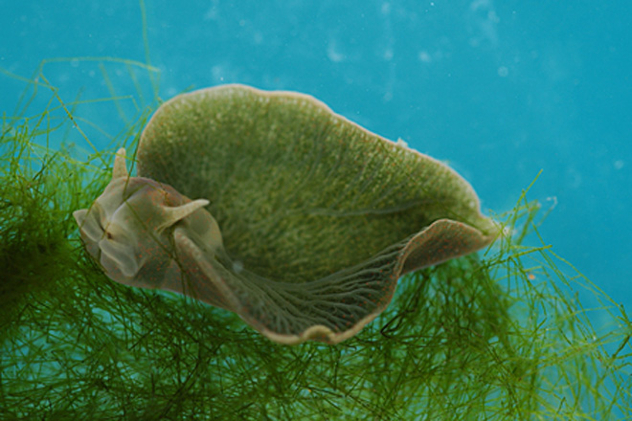
Sea slugs are much more interesting than their name suggests. As well as being, well, slugs that live in the sea they have a variety of talents. Some sea slugs can defend themselves by stealing the stinging cells from jellyfish and reusing them. Some can eject ink or slime to scare off attackers. And then there are those who cut off their own head.
Elysia marginata is a type of sea slug that thinks nothing of losing its head, or rather its entire body. Normally this sea slug lives by munching on algae. Instead of just taking all the nutrients the slugs manage to harness the chloroplasts in the algae and incorporate them into their bodies. The slugs can take energy directly from the sun. But being slugs they are relatively defenceless to a host of other animals – including parasites.
When a slug finds its body has been damaged by parasites it can sever its own head. Having decapitated themselves the head then begins to crawl around and go on feeding. Over time the slug regenerates an entirely new body. The abandoned body does not die straight away and its heart goes on beating but they never manage to grow a new head of their own.
9 Sea Cucumbers
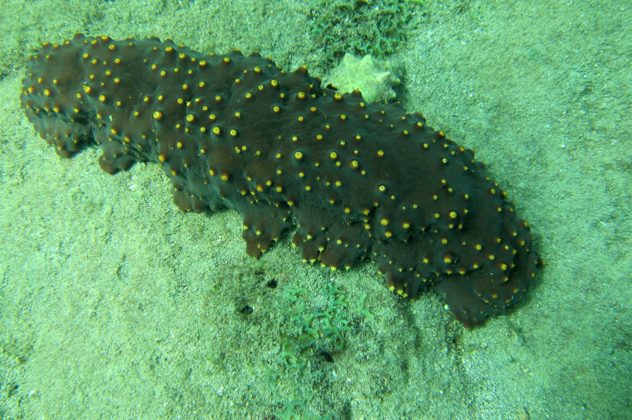
Sea cucumbers may look like slugs and live in the sea but they are not related to sea slugs. These animals generally shuffle around the ocean floor scavenging organic matter that falls down from above. Being little more than tubes of flesh they could be easy prey for other animals but they have one of the most extraordinary defences in all of nature. When a sea cucumber is threatened it can push out its internal organs to create a sticky mess that drives off an attacker in a process called evisceration.
This defence brings with it its own problems however. Once their organs are out the sea cucumbers have no way of bringing them back in. If the sea cucumber wants to live it has to grow a whole new set. And they can do this in just one to five weeks.
Regardless of whether the sea cucumber has ejected its organs out of its mouth or its posterior it begins to grow an entirely new digestive tract from both ends until it eventually meets in the middle of the organism]. Having gone through all of this effort the sea cucumber might have to do it all again if it is threatened and expels its innards.
8 Planarians
For most animals being cut in half is a major problem. The planarian worms however just shrug it off – if they happen to be the half with a head to shrug. If you cut a planarian in half you end up with two genetically identical worms that are none the worse for wear after a week of regeneration.
Planarians are fairly simple flatworms that live in water. It may be partly because of their simplicity that they can be cut up and regenerate successfully. It is not even important whether you cut them across the middle or from end to end, generally you will still end up with happy worms. They can even be cut up multiple times. Just 1/279th of a worm can grow an entirely new worm. The real secret to the worms’ powers of regeneration lay in the adult stem cells that make up 20% of their body. These cells retain the ability to form all sorts of new tissues throughout a worm’s life-cycle so can replace anything that has been lost even if it is the brain.
The new brain of cut planarians is of interest to many researchers. It is possible to train planarians to respond to certain stimuli and it seems they are able to remember this training – even after the brain the learned it has been cut off.
7 Spiny Mice Skin
Mammals are not famous for their abilities to regenerate. Once wounded they tend to heal slowly and often with a mass of scar tissue as the result. One group of mice from Africa however seems to have developed a way of avoiding this scarring.
Spiny mice are relatively small and fragile creatures. The stiff hairs on their coats may deter some predators but not many. It is when they are grabbed by a predator that they show off their special talent. They have skin that is easily torn and immediately on being grasped it automatically sloughs off. The predator is left with a mouthful of fur and skin while the mouse runs off to live another day.
Except that the escaped mouse may be missing a large portion of its skin. Over a relatively short period the mouse regrows its skin including the hair follicles, sweat glands, and other parts that are often destroyed in scarring. Scientists are hopeful that the genetic pathways used by spiny mice to regenerate tissues may be able to be activated in humans too at some point.
6 Sponges

Few animals would enjoy being pushed through a sieve or put in a blender but for sponges it is just another day in the lab. Sea sponges are among the most simple animals on the planet. They have no circulatory, nervous, or digestive systems. Their cells are largely undifferentiated and can change into a number of types over the course of a lifetime. But sponges have one big trick that allows them to thrive.
If you break up sponges into individual cells then the cells will begin to clump together again. If the groups of cells have the right make up of cell types then they will be able to grow into a full sponge. If you break up two sponges and mix their cells together then the cells from each individual are able to identify their own and will separate on their own.
This ability to regenerate from fragments is helpful in the ocean where bits may be broken from a sponge by the action of waves. The small bits of sponge can then be carried to new habitats and set up home there.
5 Lizard Tails
Autotomy is the process where an animal amputates one of its body parts. This is often done to help an animal escape a predator and one of the most famous, and slightly gruesome, examples is lizards cutting off their own tails.
Lizards are hunters and so have to go out in search of their prey but this exposes them to other animals in turn. If a lizard is grabbed on its head or body then there is not much they can do to escape but if a predator bites their tail then the lizard might have a chance. Many lizards have certain weak spots in their tail that can be weakened further by contracting their muscles. This separates the tail, vertebrae and all. The tail then falls off giving the lizard a chance to escape. Some lizard tails that have been amputated continue to wriggle to distract their attacker.
The lizard that survives losing its tail can grow another tail over a number of months. This new tail often differs from the original in that the bones that have fallen off do not regrow but are replaced with cartilage.
4 Antlers
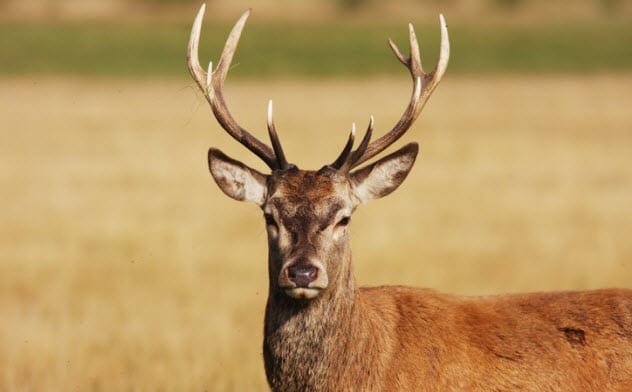
Several species of mammals, like deer and moose, grow impressive pairs of antlers. These can serve a variety of purposes. Males grow antlers to help them fight with rivals for the right to breed with females but they can also be used to fight off predators and scrape up snow to get at food. Moose may also use their large antlers to help them hear. But many people do not realise that most antlers regrow every year – and it is a bloody business.
In spring male deer shed their old antlers and new ones begin to grow. The new antlers sprout from bony ridges on the skull and can grow incredibly quickly. The new antlers are covered with a soft fur known as velvet. Inside this velvet are blood vessels that feed the growing antlers with the nutrients they need. Once grown the cartilage of the antlers is replaced with bone and the velvet falls off in a bloody mass.
It seems that the ability of antlers to regenerate entirely after being shed is due to a type of adult stem cell not normally present in mammals.
3 Starfish
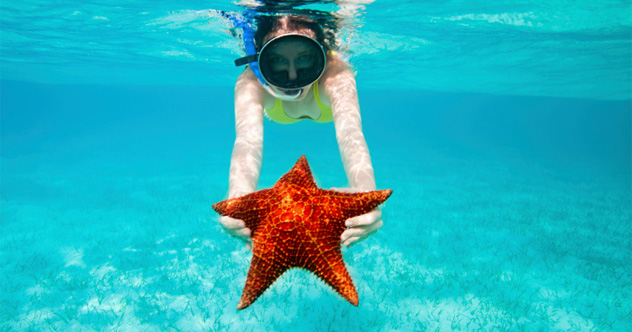
Starfish are complex animals with a relatively simple body shape. Most have a central disc with five or more arms that radiate from it. Underneath the arms are arrays of tube feet that allow the starfish to move and seek out food. The arms of the starfish however are fairly fragile and liable to get damaged or break off. What happens then is that the starfish then grows a new limb – or the severed arm grows a new starfish.
If the separated arm contains at least a portion of the central disc then it will likely be able to grow a new body. Most of the time a starfish will lose one of its arms to an attack. Sometimes the star fish will sever its own arm in an attempt to escape. If it is pulled off then it is more likely to carry part of the central disc away. If the predator does not then eat the arm the severed arm will crawl away to try and live another day with its new body.
Sometimes a young starfish may decide to reproduce asexually. Then it will break itself in half. Each half will regrow its missing limbs and the two copies go their separate ways.
2 Hydra
Hydra are miniscule water-dwelling organisms with a simple structure. They have a head with stinging tentacles and a foot that can attach them to solid objects. They live by capturing prey with their tentacles and forcing them into their stomach. Once their food is digested the hydra will push the remains out of their mouth because they have no anus. That may not sound like much of a life but hydra seems to make the most of it – they may well be immortal.
If you take a hydra and cut it in half then each half will regenerate into a smaller hydra. If you cut them up into many fragments then you might end up with many hydra. This is because most of a hydra is made up of stem cells, each with the ability to grow into an entirely new hydra. So long as portions of the protein skeleton of the hydra survive the cutting then the organism can reform perfectly.
The stem cells of the hydra also explain their immortality. Throughout their lives their stem cells keep replenishing themselves. As long a hydra is in a good and safe environment it will never grow old.
1 Axolotls
Regeneration is a trick common to many small organisms but it is far rarer in vertebrate animals but one, the Axolotl, is a master of it. These amphibians can regrow whole limbs, heal their spinal cords, regenerate their tails, and parts of their hearts and eyes. Their fantastic regeneration abilities have made them a model organism for scientists.
When some organisms regrow a body part the replacement is not as good as the original. In axolotls the regenerated tissue is indistinguishable from the original. The axolotls are able to do this by taking matured tissues like blood and muscles around the point of amputation revert to undifferentiated cells similar to stem cells. The stem cells then grow as if they were developing in new born axolotl. And they can do this any number of times. If you were a sufficiently sadistic researcher you could continue cutting off an axolotl leg forever and it would always grow back.
One thing the axolotls cannot regenerate is their natural habitat. Today they are found in only a few places near Mexico City.
10 Amazing Animals That Clone Themselves
